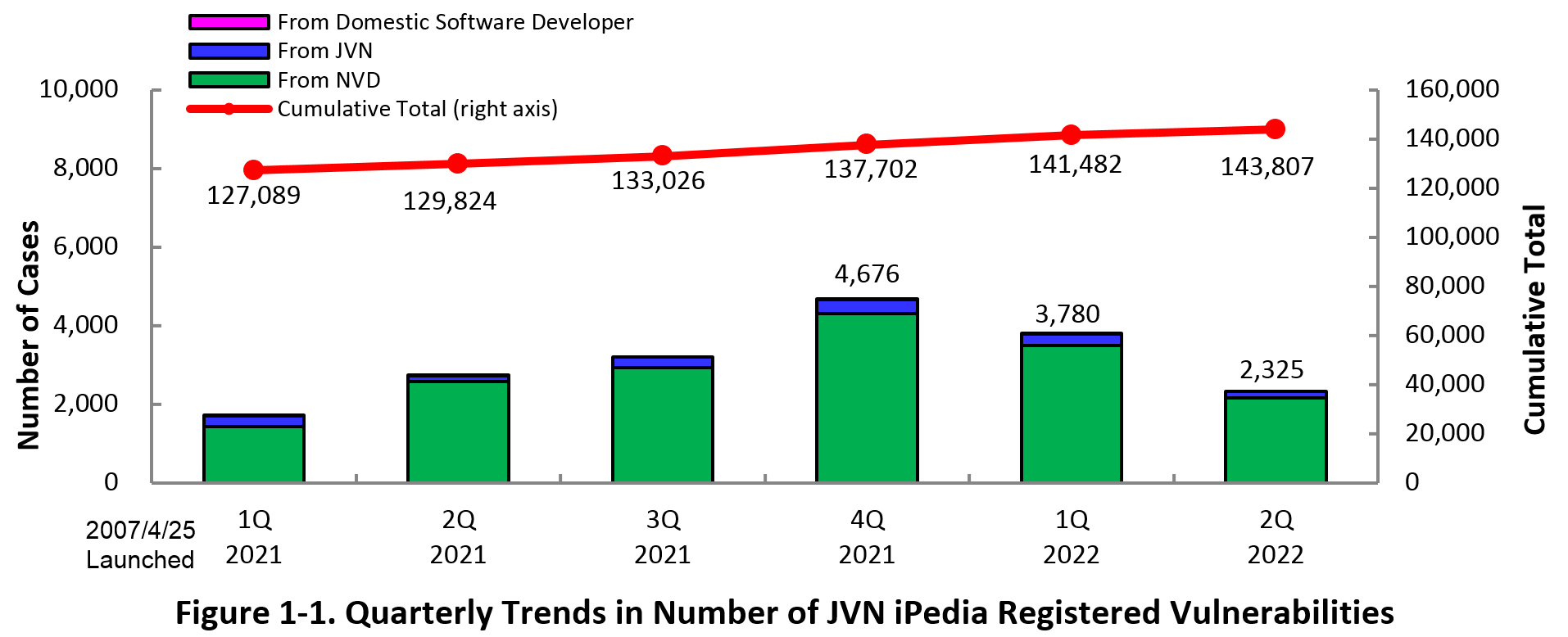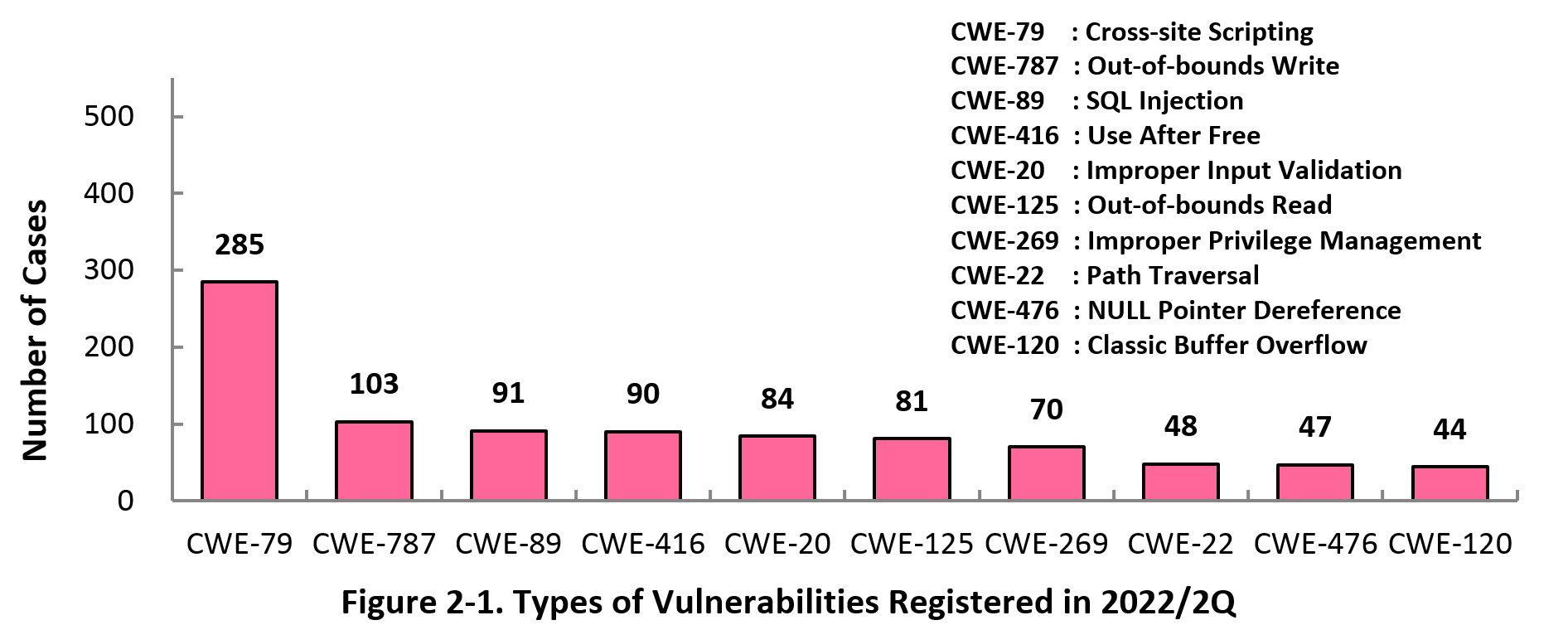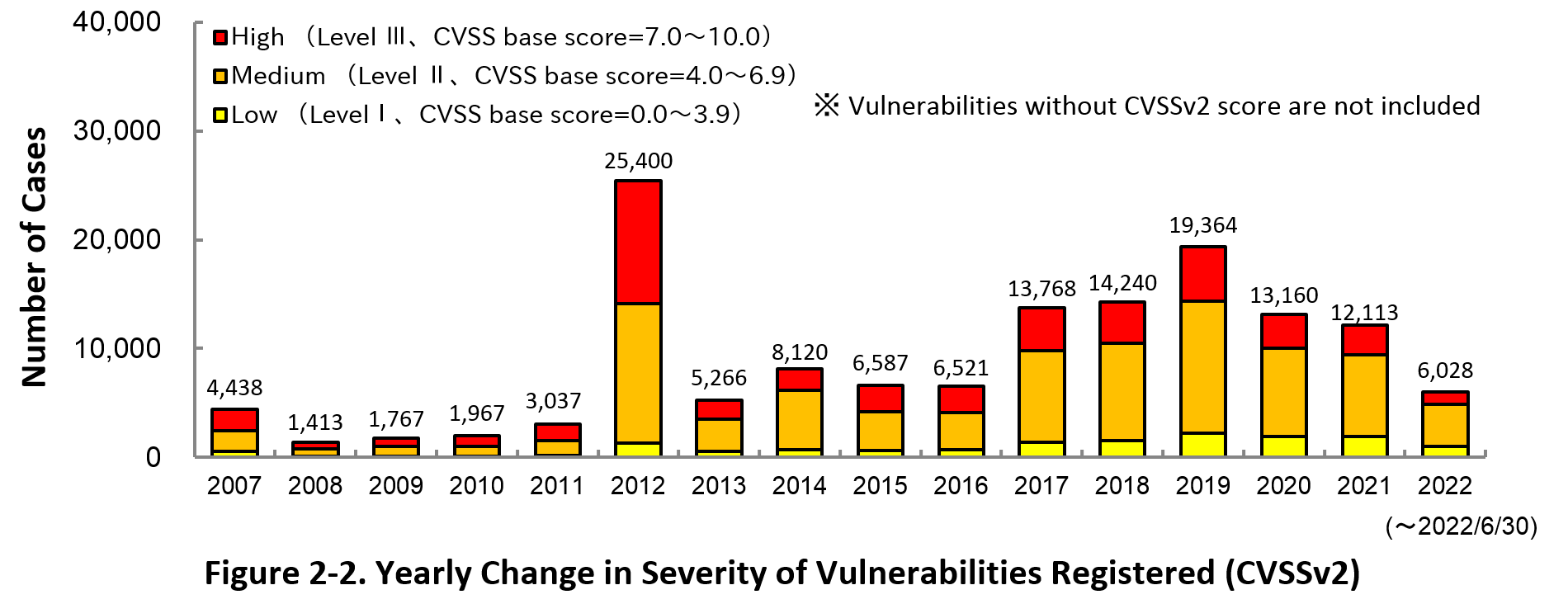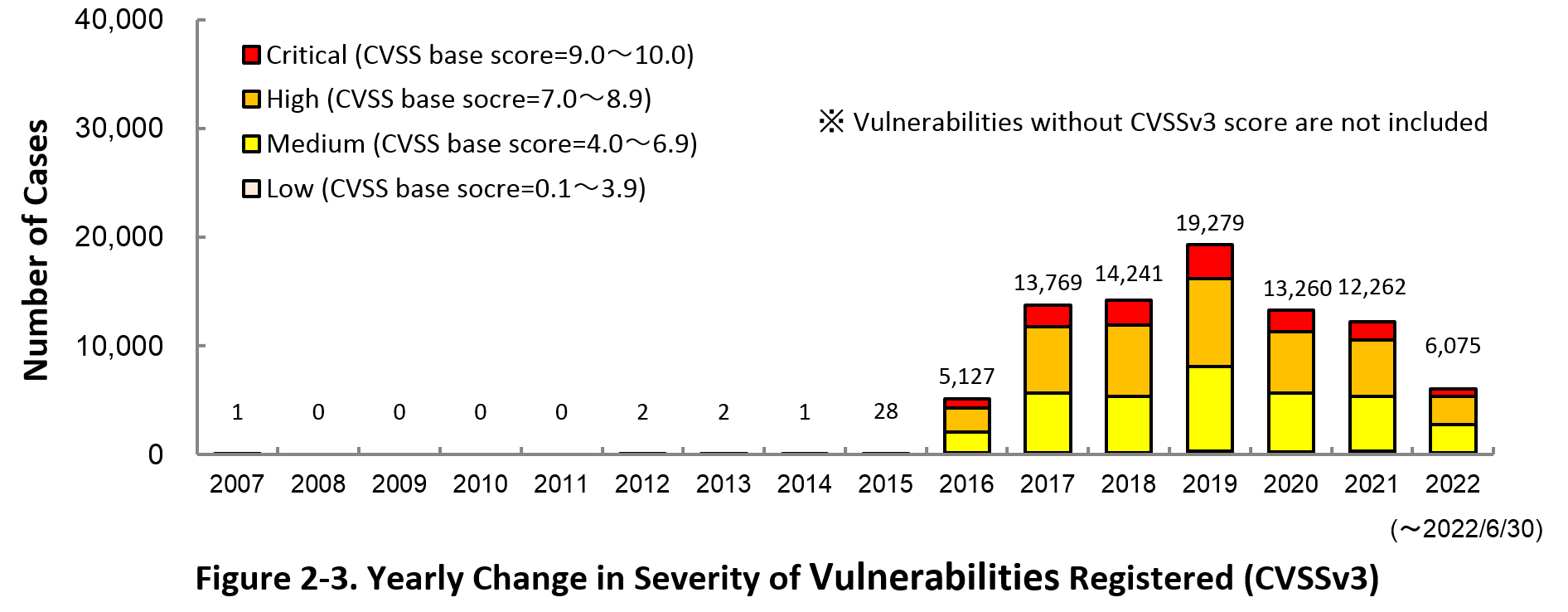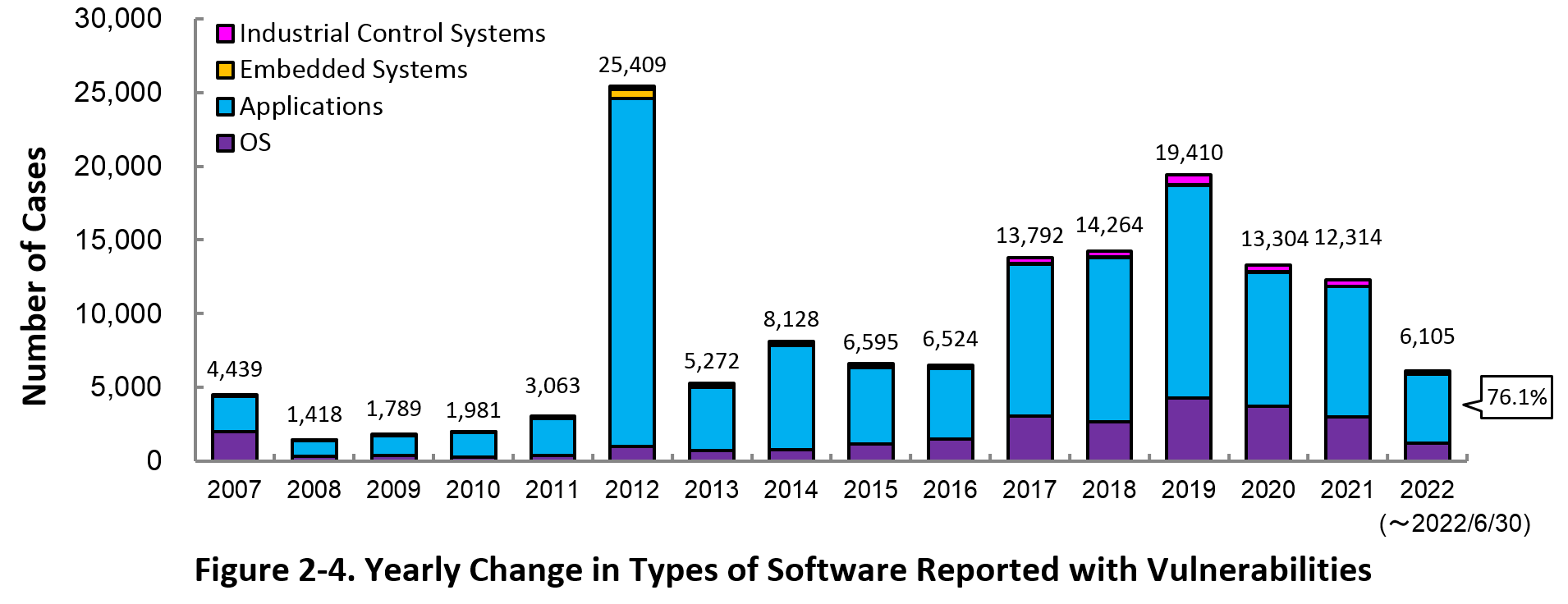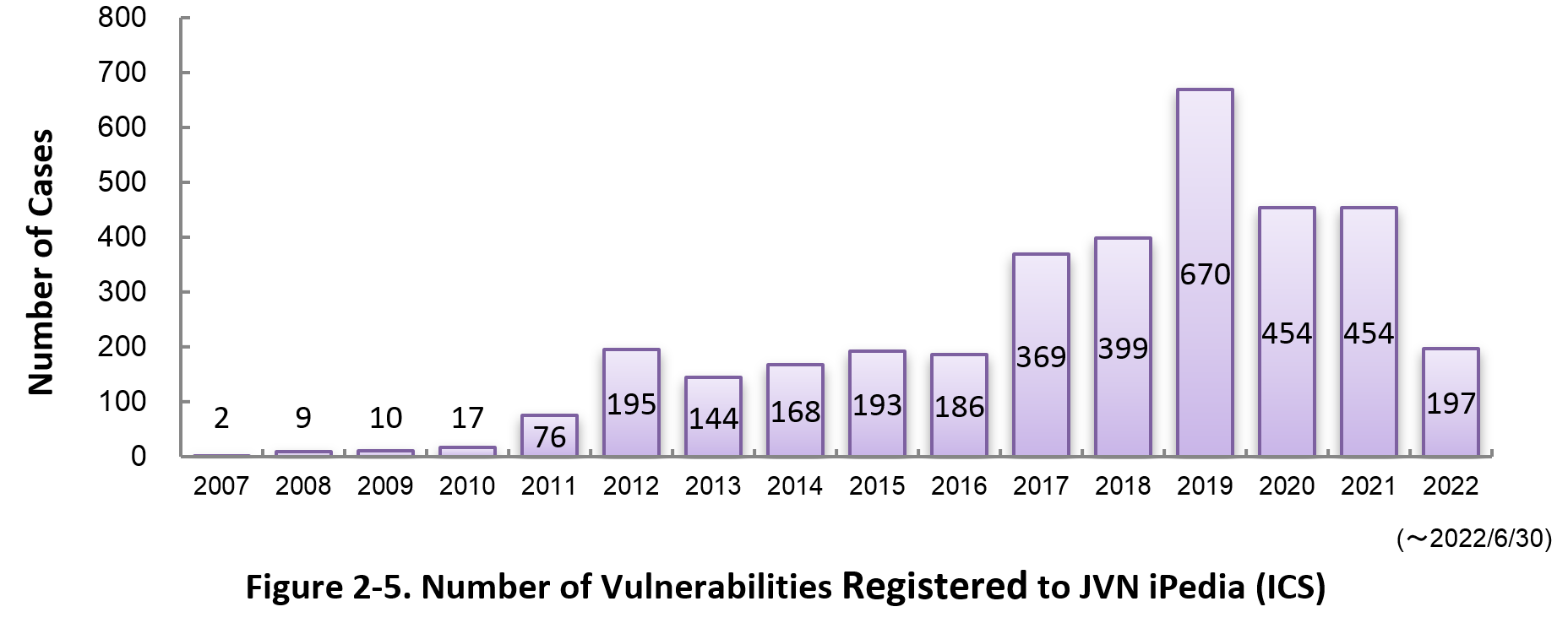Enhancing information security

Vulnerability Countermeasure Information Database JVN iPedia Registration Status [2022 2nd Quarter (Apr. - Jun.)]
Release Date:Aug 24, 2022
IT Security Center
1. 2022 2nd Quarter: Vulnerability Countermeasure Information Database JVN iPedia Registration Status
The vulnerability countermeasure information database JVN iPedia (https://jvndb.jvn.jp/en/) is endeavoring to become a comprehensive vulnerability database where vulnerability information is aggregated for easy access for IT users. JVN iPedia collects and/or translates the vulnerability information published by 1) domestic software developers, 2) JVN (*1), a vulnerability information portal run by JPCERT/CC and IPA, and 3) NVD (*2), a vulnerability database run by NIST (*3). JVN iPedia has been making vulnerability information available to the public since April 25, 2007.
1-1. Vulnerabilities Registered in 2022/2Q
~ JVN iPedia now stores 143,807 vulnerabilities ~
The summary of the vulnerability information registered to the Japanese version of JVN iPedia during the 2nd quarter of 2022 (April 1 to June 30, 2022) is shown in the table below. As of the end of June 2022, the total number of vulnerabilities stored in JVN iPedia is 143,807 (Table 1-1, Figure 1-1).
As for the JVN iPedia English version, the total number of vulnerabilities stored is 2,447 as shown in the lower half of the Table 1-1.
Table 1-1. Vulnerabilities Registered to JVN iPedia during 2nd Quarter of 2022
|
|
Information Source
|
Registered Cases
|
Cumulative Cases
|
|---|---|---|---|
|
Japanese Version
|
Domestic Product Developers
|
0 cases
|
264 cases
|
|
JVN
|
171 cases
|
11,331 cases
|
|
|
NVD
|
2,154 cases
|
132,212 cases
|
|
|
Total
|
2,325 cases
|
143,807 cases
|
|
|
English Version
|
Domestic Product Developers
|
0 cases
|
259 cases
|
|
JVN
|
33 cases
|
2,188 cases
|
|
|
Total
|
33 cases
|
2,447 cases
|
2. Details on JVN iPedia Registered Data
2-1. Types of Vulnerabilities Reported
Figure 2-1 shows the number of vulnerabilities newly added to JVN iPedia during the 2nd quarter of 2022, sorted by the CWE vulnerability types.
The type of the vulnerabilities reported most in the 2nd quarter is CWE-79 (Cross-Site Scripting) with 285 cases, followed by CWE-787 (Out-of-bounds Write) with 103, CWE-89 (SQL Injection) with 91, CWE-416 (Use After Free) with 90, CWE-20 (Improper Input Validation) with 84. CWE-79 (Cross-site Scripting), the most reported vulnerability type in this quarter, could allow attackers to display false webpages and/or steal information.
Software developers need to make sure to mitigate vulnerability from the planning and design phase of software development. IPA provides tools and guidelines, such as "Vulnerability Countermeasure Guide for Software Developers"" (*4), "How to Secure Your Website" (*5), "Secure Programming Guide" (*6) and "AppGoat" (*7), a hands-on venerability learning tool, for website developers and operators to build secure websites.
2-2. Severity of Vulnerabilities Reported
Figure 2-2 shows the yearly change in the CVSSv2 rating scale based severity of vulnerabilities registered to JVN iPedia.
As for the vulnerabilities added to JVN iPedia in 2022, 19.2 percent are “Level III” (7.0 - 10.0), 64.0 percent are “Level ll” (4.0 – 6.9) and 16.8 percent are “Level I” (0.0 – 3.9). This means 83.2 percent of all vulnerabilities registered are Level II or higher, which are potentially critical enough to cause damage like information exposure or data falsification.
Figure 2-3 shows the yearly change in the CVSSv3 rating scale based severity of vulnerabilities registered to JVN iPedia.
As for the vulnerabilities added to JVN iPedia in 2022, 11.4 percent are “Critical” (9.0 – 10.0), 42.5 percent are “High” (7.0 – 8.9), 43.4 percent are “Medium” (4.0 – 6.9) and 2.7 percent are “Low” (0.1 – 3.9).
To avoid threats posed by the known vulnerabilities, both product developers and IT users should pay close attention to vulnerability disclosure and update software they use to a fixed version or apply a security patch as soon as possible when they become available. IT users can check vulnerabilities newly published on JVN iPedia in RSS and XML format (*8) as well.
2-3. Types of Software Reported with Vulnerability
Figure 2-4 shows the yearly change in the type of software reported with vulnerability. Application vulnerabilities have been published most, accounting for 76.1 percent (4,644 out of 6,105) of the 2022 total.
Figure 2-5 shows the yearly change in the number of JVN iPedia-stored vulnerabilities in industrial control systems (ICS) used in critical infrastructure sectors. As of June 2022, the total of 3,543 ICS vulnerabilities have been registered.
2-4. Products Reported with Vulnerability
Table 2-1 lists the top 20 software whose vulnerabilities were most registered to JVN iPedia during the 2nd quarter (April to June) of 2022.
In this quarter, the most registered products were Qualcomm products which continued from previous quarter, with 230 cases. This is due to the registration of vulnerability information for multiple Qualcomm products which was published in 2021. In addition, Microsoft Windows products ranked from 2nd to 12th.
Besides those in the top 20 list, JVN iPedia stores and offers vulnerability information about a variety of software. IPA hopes software developers and users will make good use of JVN iPedia to efficiently check vulnerability information and take necessary action in a timely manner (*9).
Table 2-1. Top 20 most registered software products vulnerability countermeasure information in JVN iPedia [Apr. – Jun. 2022]
|
Rank
|
Category
|
Product Name (Vendor)
|
Number of
Vulnerabilities Registered |
|---|---|---|---|
|
1
|
Firmware
|
Qualcomm component (Qualcomm)
|
230
|
|
2
|
OS
|
Microsoft Windows Server (Microsoft)
|
180
|
|
3
|
OS
|
Microsoft Windows Server 2022 (Microsoft)
|
179
|
|
4
|
OS
|
Microsoft Windows Server 2019 (Microsoft)
|
176
|
|
5
|
OS
|
Microsoft Windows Server 2016 (Microsoft)
|
163
|
|
6
|
OS
|
Microsoft Windows 10 (Microsoft)
|
142
|
|
7
|
OS
|
Microsoft Windows 11 (Microsoft)
|
136
|
|
8
|
OS
|
Microsoft Windows Server 2012 (Microsoft)
|
131
|
|
9
|
OS
|
Microsoft Windows 8.1 (Microsoft)
|
104
|
|
10
|
OS
|
Microsoft Windows RT 8.1 (Microsoft)
|
102
|
|
11
|
OS
|
Microsoft Windows Server 2008 (Microsoft)
|
96
|
|
12
|
OS
|
Microsoft Windows 7 (Microsoft)
|
85
|
|
13
|
PDF Viewer/Editor
|
Adobe Acrobat DC (Adobe Systems)
|
78
|
|
13
|
PDF Viewer
|
Adobe Acrobat Reader DC (Adobe Systems)
|
78
|
|
15
|
PDF Viewer/Editor
|
Adobe Acrobat (Adobe Systems)
|
71
|
|
16
|
OS
|
Fedora (Fedora Project)
|
65
|
|
17
|
Others
|
Google TensorFlow (Google)
|
58
|
|
18
|
OS
|
Debian GNU/Linux (Debian)
|
51
|
|
19
|
Others
|
Teamcenter Visualization (Siemens)
|
45
|
|
19
|
Others
|
JT2Go (Siemens)
|
45
|
3. Most Accessed Vulnerability Countermeasure Information
Table 3-1 lists the top 20 most accessed vulnerability countermeasure information in JVN iPedia during the 2nd quarter of 2022 (April to June).
In this quarter, vulnerability countermeasure information of Spring Framework, which was published on March 31, 2022 and attracted much attention under the name Spring4Shell, ranked first.
In addition, 19 of the top 20 were those published on JVN, a vulnerability countermeasure information portal site.
Rating Scale
Note 1) CVSSv2 Severity Rating Scale
- Level I (Low)
- CVSS Base Score = 0.0~3.9
- Level II (Medium)
- CVSS Base Score = 4.0~6.9
- Level III (High)
- CVSS Base Score = 7.0~10.0
Note 2) CVSSv3 Severity Rating Scale
- Low
- CVSS Base Score =0.1~3.9
- Medium
- CVSS Base Score =4.0~6.9
- High
- CVSS Base Score =7.0~8.9
- Critical
- CVSS Base Score =9.0~10.0
Table 3-1. Top 20 Most Accessed Vulnerability Countermeasure Information in JVN iPedia [Apr. – Jun. 2022]
No.1 Arbitrary code execution vulnerability in Spring Framework due to improper data binding process JVNDB-2022-001498
- CVSSv2 Base Score
-
-
- CVSSv3 Base Score
-
-
- Date Public
-
2022/4/5
- Access Count
-
9,671
No.2 Multiple vulnerabilities in Operation management interface of FUJITSU Network IPCOM JVNDB-2022-000030
- CVSSv2 Severity Rating Scale
-
- Level III (High)
- CVSSv2 Base Score
-
10.0
- CVSSv3 Severity Rating Scale
-
Critical
- CVSSv3 Base Score
-
9.8
- Date Public
-
2022/5/9
- Access Count
-
8,870
No.3 WordPress vulnerable to cross-site scripting JVNDB-2022-000023
- CVSSv2 Severity Rating Scale
-
Level II (Medium)
- CVSSv2 Base Score
-
4.0
- CVSSv3 Severity Rating Scale
-
Medium
- CVSSv3 Base Score
-
6.5
- Date Public
-
2022/3/30
- Access Count
-
7,785
No.4 Trend Micro Apex Central and Trend Micro Apex Central as a Service vulnerable to improper check for file contents JVNDB-2022-001494
- CVSSv2 Base Score
-
-
- CVSSv3 Severity Rating Scale
-
High
- CVSSv3 Base Score
-
8.6
- Date Public
-
2022/3/30
- Access Count
-
6,864
No5. Zero-channel BBS Plus vulnerable to cross-site scripting JVNDB-2022-000024
- CVSSv2 Severity Rating Scale
-
Level II (Medium)
- CVSSv2 Base Score
-
4.3
- CVSSv3 Severity Rating Scale
-
Medium
- CVSSv3 Base Score
-
6.1
- Date Public
-
2022/3/30
- Access Count
-
6,816
No.6 AttacheCase may insecurely load Dynamic Link Libraries JVNDB-2022-000022
- CVSSv2 Severity Rating Scale
-
- Level II (Medium)
- CVSSv2 Base Score
-
6.8
- CVSSv3 Severity Rating Scale
-
- High
- CVSSv3 Base Score
-
7.8
- Date Public
-
2022/3/30
- Access Count
-
6,781
No.7 Trend Micro Antivirus for Mac vulnerable to privilege escalation JVNDB-2022-001526
- CVSSv2 Base Score
-
-
- CVSSv3 Base Score
-
-
- Date Public
-
2022/4/7
- Access Count
-
6,443
No.8 Hammock AssetView missing authentication for critical functions JVNDB-2022-000027
- CVSSv2 Severity Rating Scale
-
Level III (High)
- CVSSv2 Base Score
-
9.3
- CVSSv3 Severity Rating Scale
-
Critical
- CVSSv3 Base Score
-
9.0
- Date Public
-
2022/4/22
- Access Count
-
6,104
No.9 Apache HTTP Server vulnerable to HTTP Request Smuggling (in Japanese only) JVNDB-2022-001479
- CVSSv2 Severity Rating Scale
-
Level III (High)
- CVSSv2 Base Score
-
7.5
- CVSSv3 Severity Rating Scale
-
Critical
- CVSSv3 Base Score
-
9.8
- Date Public
-
2022/3/23
- Access Count
-
6,074
No.10 WordPress Plugin "MicroPayments - Paid Author Subscriptions, Content, Downloads, Membership" vulnerable to cross-site request forgery JVNDB-2022-000026
- CVSSv2 Severity Rating Scale
-
Level I (Low)
- CVSSv2 Base Score
-
2.6
- CVSSv3 Severity Rating Scale
-
Medium
- CVSSv3 Base Score
-
4.3
- Date Public
-
2022/4/15
- Access Count
-
6,072
No.11 Multiple vulnerabilities in KINGSOFT "WPS Office" and "KINGSOFT Internet Security" JVNDB-2022-000021
- CVSSv2 Severity Rating Scale
-
- Level II (Medium)
- CVSSv2 Base Score
-
6.8
- CVSSv3 Severity Rating Scale
-
- High
- CVSSv3 Base Score
-
8.8
- Date Public
-
2022/3/16
- Access Count
-
5,447
No.12 Netcommunity OG410X and OG810X VoIP gateway/Hikari VoIP adapter for business offices vulnerable to OS command injection JVNDB-2022-001477
- CVSSv2 Base Score
-
-
- CVSSv3 Severity Rating Scale
-
High
- CVSSv3 Base Score
-
8.0
- Date Public
-
2022/3/23
- Access Count
-
5,274
No.13 Multiple vulnerabilities in CLUSTERPRO X and EXPRESSCLUSTER X JVNDB-2021-000097
- CVSSv2 Severity Rating Scale
-
Level III (High)
- CVSSv2 Base Score
-
10.0
- CVSSv3 Severity Rating Scale
-
Critical
- CVSSv3 Base Score
-
9.8
- Date Public
-
2021/10/29
- Access Count
-
5,248
No.14 Multiple vulnerabilities in pfSense JVNDB-2022-000020
- CVSSv2 Severity Rating Scale
-
Level III (High)
- CVSSv2 Base Score
-
9.0
- CVSSv3 Severity Rating Scale
-
High
- CVSSv3 Base Score
-
7.2
- Date Public
-
2022/3/15
- Access Count
-
5,100
No.15 Multiple vulnerabilities in multiple ELECOM routers JVNDB-2021-004912
- CVSSv2 Base Score
-
-
- CVSSv3 Severity Rating Scale
-
High
- CVSSv3 Base Score
-
8.8
- Date Public
-
2021/12/2
- Access Count
-
4,965
No.16 OpenKM vulnerable to cross-site scripting JVNDB-2014-007972
- CVSSv2 Severity Rating Scale
-
- Level I (Low)
- CVSSv2 Base Score
-
3.5
- CVSSv3 Base Score
-
-
- Date Public
-
2015/3/13
- Access Count
-
4,924
No.17 i-FILTER vulnerable to improper check for certificate revocation JVNDB-2022-000008
- CVSSv2 Severity Rating Scale
-
Level II (Medium)
- CVSSv2 Base Score
-
4.0
- CVSSv3 Severity Rating Scale
-
Medium
- CVSSv3 Base Score
-
4.8
- Date Public
-
2022/3/4
- Access Count
-
4,805
No.18 Multiple vulnerabilities in OMRON CX-Programmer JVNDB-2022-001384
- CVSSv2 Base Score
-
-
- CVSSv3 Severity Rating Scale
-
High
- CVSSv3 Base Score
-
7.8
- Date Public
-
2022/3/7
- Access Count
-
4,626
No.19 UNIVERGE WA Series vulnerable to OS command injection JVNDB-2022-000016
- CVSSv2 Severity Rating Scale
-
Level II (Medium)
- CVSSv2 Base Score
-
5.8
- CVSSv3 Severity Rating Scale
-
High
- CVSSv3 Base Score
-
8.8
- Date Public
-
2022/3/10
- Access Count
-
4,507
No.20 Multiple vulnerabilities in a-blog cms JVNDB-2022-000014
- CVSSv2 Severity Rating Scale
-
Level II (Medium)
- CVSSv2 Base Score
-
6.8
- CVSSv3 Severity Rating Scale
-
Medium
- CVSSv3 Base Score
-
5.6
- Date Public
-
2022/2/18
- Access Count
-
4,488
Table 3-2 lists the top 5 most accessed vulnerability information among those reported by domestic product developers.
Table 3-2. Top 5 Most Accessed Vulnerabilities Reported by Domestic Product Developers [Apr. - Jun. 2022]
No.1 File Permission Vulnerability in Hitachi Command Suite JVNDB-2022-001382
- CVSSv2 Base Score
-
- -
- CVSSv3 Base Score
-
- -
- Date Public
-
2022/3/7
- Access Count
-
4,441
No.2 Directory Permission Vulnerability in Hitachi Ops Center Viewpoint JVNDB-2022-001383
- CVSSv2 Base Score
-
- -
- CVSSv3 Base Score
-
-
- Date Public
-
2022/3/7
- Access Count
-
4,394
No.3 Cross-site Scripting Vulnerability in JP1/IT Desktop Management 2 JVNDB-2022-001299
- CVSSv2 Base Score
-
-
- CVSSv3 Base Score
-
-
- Date Public
-
2022/2/8
- Access Count
-
4,310
No.4 Authentication Bypass Vulnerability in Hitachi Device Manager JVNDB-2021-003660
- CVSSv2 Base Score
-
-
- CVSSv3 Base Score
-
-
- Date Public
-
2021/11/1
- Access Count
-
4,225
No.5 Information Disclosure Vulnerability in Hitachi Tuning Manager, Hitachi Infrastructure Analytics Advisor and Hitachi Ops Center Analyzer JVNDB-2021-002810
- CVSSv2 Base Score
-
-
- CVSSv3 Base Score
-
-
- Date Public
-
2021/10/5
- Access Count
-
4,204
Footnotes
-
(*1)
-
(*2)
-
(*3)
-
(*4)
-
(*5)
-
(*6)
-
(*7)
-
(*8)
-
(*9)
Past Quarterly Reports
Contact information
IT Security Center,
Information-technology Promotion Agency, Japan (ISEC/IPA)

